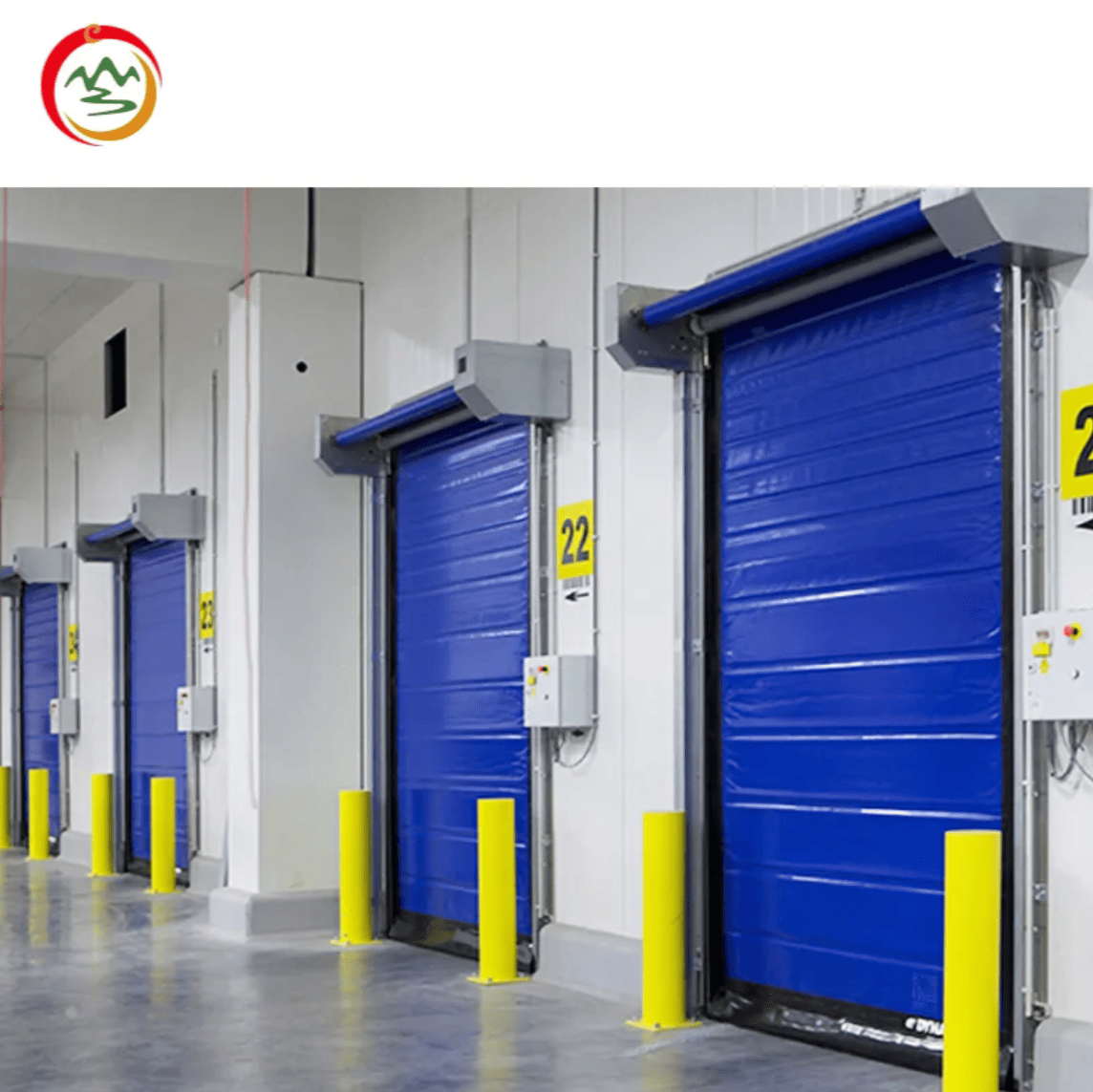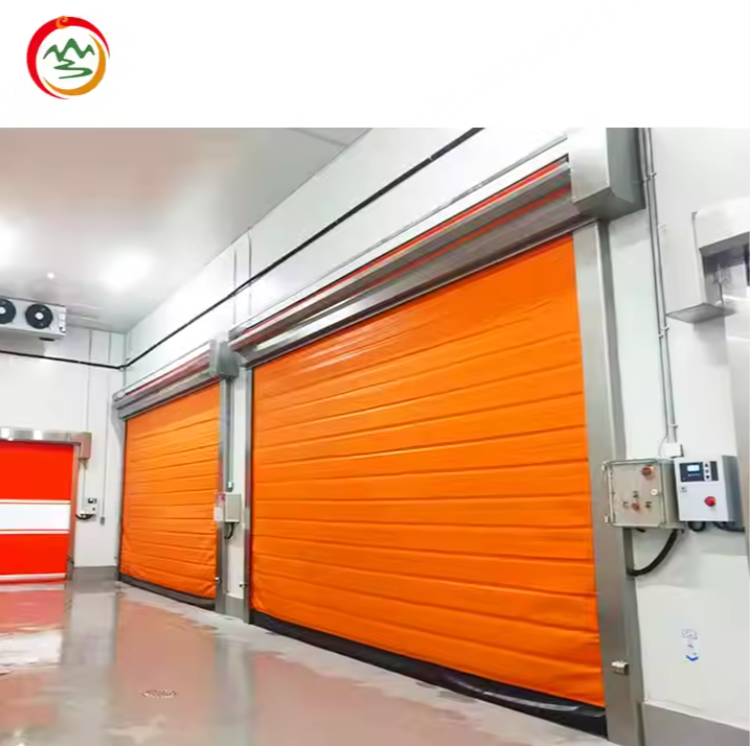Technological Requirements for PVC Cold Storage Rolling Shutter Doors
The technological requirements for PVC cold storage rolling shutter doors cover multiple aspects. The following are the main requirements:

1. Material Selection
-
PVC Material: PVC materials with good low - temperature resistance should be selected. They need to maintain flexibility and toughness in the low - temperature environment of cold storage and not be prone to cracking. Meanwhile, the PVC material should have a certain strength and wear resistance to withstand frequent opening and closing operations.
-
Reinforcing Bars: To enhance the overall strength of the rolling shutter door, reinforcing bars made of fiberglass or other high - strength materials can be added inside the PVC curtain sheets. The distribution and density of the reinforcing bars should be reasonably designed according to the size and usage requirements of the door to ensure that the rolling shutter door will not deform or break during the lifting process.
-
Sealing Materials: High - quality sealing materials such as rubber sealing strips should be used at the connection between the door frame and the curtain sheets. The sealing materials should have good elasticity and low - temperature resistance, and be able to maintain a tight seal in low - temperature conditions to prevent cold air leakage.
2. Curtain Sheet Production
-
Dimensional Accuracy: The dimensions of the curtain sheets should be strictly produced according to the design requirements, with the accuracy controlled within a small range. The deviations in the width, length, and thickness of the curtain sheets should meet relevant standards to ensure a tight connection between the curtain sheets and a good overall flatness of the rolling shutter door.
-
Surface Quality: The surface of the curtain sheets should be smooth and flat, free of defects such as bubbles, cracks, and scratches. The smoothness of the surface not only affects the aesthetics of the rolling shutter door but also facilitates its cleaning and maintenance. In addition, the color of the curtain sheets should be uniform and not fade easily.
- Connection Method: Usually, welding or hot - melt connection methods are used between the curtain sheets. The connection parts should be firm and reliable. The welding strength should meet the usage requirements of the rolling shutter door to avoid the curtain sheets falling off during use. At the same time, the connection points should be as flat as possible to reduce the impact on the operation of the rolling shutter door.

3. Door Body Assembly
-
Roller Installation: The roller is a key component of the rolling shutter door, and its installation accuracy directly affects the operation stability of the door. The roller should be installed horizontally, and the bearing seats at both ends should be firmly fixed to ensure that the roller does not shake or deviate during rotation. The diameter and wall thickness of the roller should be reasonably selected according to the size and weight of the door to ensure its load - bearing capacity.
-
Drive Device Installation: The drive device usually uses an electric motor or a manual rocker. The power of the electric motor should be matched with the weight and operating speed of the rolling shutter door to ensure that the door can be lifted and lowered smoothly and quickly. The installation position of the drive device should be convenient for operation and maintenance, and waterproof and moisture - proof measures should be taken to prevent damage due to the humid environment in the cold storage.
-
Limit Device Installation: To prevent the rolling shutter door from over - lifting or lowering, a limit device needs to be installed. The limit device should be accurate and reliable, and be able to stop the operation of the rolling shutter door in time when it reaches the specified position. The adjustment of the limit device should be convenient and flexible, and can be accurately adjusted according to actual needs.
-
Door Frame Installation: The door frame should be installed vertically and horizontally, and be firmly connected to the wall. The sealing surface of the door frame should be flat, and the fit with the curtain sheets should be tight to ensure a good sealing effect. During the installation process, the surface of the door frame should be protected to avoid scratches or deformation.
4. Surface Treatment
-
Anti - Corrosion Treatment: Since the environment in the cold storage is relatively humid, the metal parts of the rolling shutter door are prone to rust and corrosion. Therefore, the metal parts such as the roller, bearing seats, and door frame should be anti - corrosion treated, such as spraying anti - rust paint or galvanizing. The surface after anti - corrosion treatment should be uniform and smooth, free of defects such as missed coating and blistering, to improve the corrosion resistance and service life of the metal parts.
-
Insulation Treatment: To reduce the loss of cold energy in the cold storage, insulation materials can be added to the curtain sheets or door frame of the rolling shutter door. The insulation materials should have good insulation performance and low - temperature resistance, and should not affect the normal operation of the rolling shutter door. The insulation materials should be firmly installed to prevent falling off or displacement during use.
5. Quality Inspection
-
Appearance Inspection: Check whether the appearance of the rolling shutter door meets the requirements, including the surface quality of the curtain sheets, color consistency, and the installation flatness of the door frame and roller. Any appearance defects found should be repaired or replaced in time.
-
Dimensional Inspection: Measure various dimensions of the rolling shutter door, such as the width and length of the curtain sheets, the diameter of the roller, and the size of the door frame, to ensure that they meet the design requirements. If the dimensional deviation exceeds the allowable range, adjustments or re - production should be carried out.
-
Performance Testing: Conduct performance tests on the rolling shutter door, including lifting speed, operation stability, accuracy of the limit device, and sealing performance. The lifting speed should meet the design requirements, and there should be no jamming or shaking during operation. The limit device should be able to accurately control the lifting position of the rolling shutter door, and the sealing performance should be good, which can be evaluated by detecting the leakage amount.
- Strength Testing: Conduct strength tests on the rolling shutter door, simulating the maximum load it may bear during use, and check the strength and stability of components such as the curtain sheets, roller, and door frame. The strength tests should meet relevant standards and specifications to ensure the safe and reliable use of the rolling shutter door.

